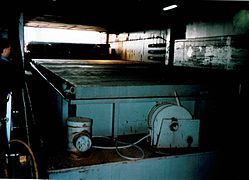Baco liner
|
The Baco-Liner 2 in the port of Hamburg
|
||||||||||||||||||
|
||||||||||||||||||
|
||||||||||||||||||
|
||||||||||||||||||
|
||||||||||||||||||
|
||||||||||||||||||
Baco-Liner was the name of three special ships , so-called BACO-carriers , which could load floating cargo in space and containers on deck .
history
The system of the Baco-Liner was jointly developed at the end of the 1970s by the Bremen captain H. Möncke and the Rhein-, Maas- und See-Schiffahrtkontor (RMS) in Duisburg . The three units were built in 1979, 1980 and 1984 at Thyssen Nordseewerke GmbH .
The Baco-Liner 3 was decommissioned in 2012 and reached Alang on July 30, 2012 for demolition . Baco-Liner 2 arrived on July 7, 2013 for scrapping in Gadani, Pakistan, and Baco-Liner 1 finally followed there on September 17, 2013.
The system
In contrast to lash carriers , which can load special, buoyant lighters on deck, or dock ships whose rooms are open at the top or whose hatches do not have to be permanently closed with hatch covers after loading , the rooms of the Baco-Liner were permanently enclosed . The loading took place via bow doors. The ships were lowered by flooding ballast tanks so that floating cargo could be swum into the rooms . In addition to the barges belonging to the Baco-Liner transport system, of which there was space for up to twelve in the rooms, other floating cargo could also be transported, provided that the dimensions of the rooms were 144 × 9.5 × 9.5 m (L × W × H) were not exceeded.
In addition, up to 652 or 656 TEU could be stowed in four layers on the deck of the ships . The ships had an on-board loading crane that could lift 40 t.
The Baco-Liner system was designed for West African ports . Due to the possibility of loading and unloading the ships independently (this could also be done outside of port facilities, e.g. in roadsteads or in river mouths ), the ships were overcrowded in the West African ports, which often led to a delay in handling in the port, only slightly or not at all affected. The barges that remained in the loading and unloading ports could be loaded or unloaded when the mother ship, the Baco-Liner, had already left the port.
The ship's propulsion system consisted of an eight - cylinder two - stroke diesel engine that acted directly on a fixed propeller. For the first two Baco-Liners, an eight-cylinder two-stroke diesel engine of the type 8 L 55 GF from Burmeister & Wain with an output of 7880 kW was built in Denmark , the following Baco-Liner 3 received one from Mitsui Engineering & Shipbuilding in Tamano in Seven - cylinder engine of the type B&W 7 L 55 GFCA with 7350 kW power built under license .
The ships
| Baco liner | ||||
|---|---|---|---|---|
| Surname | Construction year | Build number | IMO number | Whereabouts |
| Baco liner 1 | 1979 | 7812115 | Decommissioned in 2013, scrapped |
|
| Baco liner 2 | 1980 | 7904621 | Decommissioned in 2013, scrapped |
|
| Baco liner 3 | 1984 | 8203696 | Decommissioned in 2012, scrapped |
|
Shipping area of the ships
The ships ran according to a fixed timetable and called at the following ports:
- West Africa:
- Nouadhibou , Mauritania
- Nouakchott , Mauritania
- San Pedro, Ivory Coast
- Takoradi , Ghana
- Lagos , Nigeria
- Calabar , Nigeria
- Port Harcourt , Nigeria
A round trip took about six weeks.
photos
- Baco liner
Baco-Liner 1 in the dock at Blohm + Voss in Hamburg
Attack on the Baco-Liner 2
On January 20, 2007, the Baco-Liner 2 was attacked by Nigerian rebels en route to Warri, and all 24 Filipino seamen on board were abducted. The seafarers were only released after more than three weeks. The Schifffahrts-Zeitung THB - Deutsche Schiffahrts-Zeitung suspected in this connection that some kidnappers were pursuing political goals and protesting against the living conditions in the impoverished Niger Delta, while others were only after the ransom.
Web links
- Baco-Liner shipping company ( Memento from October 18, 2014 in the Internet Archive )
Individual evidence
- ↑ E. de Jong: Bremer Kapitän develops special ship in: Kehrwieder , Vol. 23, No. 6, June 1979, Association of German Shipowners , Hamburg, p. 21.
- ↑ After only 17 years to Indian dropouts ( memento of August 2, 2012 in the Internet Archive ), THB - Deutsche Schiffahrts-Zeitung , July 30, 2012. Retrieved on August 13, 2012.
- ↑ Crew members released ( memento from February 18, 2013 in the web archive archive.today ), THB - Deutsche Schiffahrts-Zeitung, February 14, 2007.







